

Shiitake "Farming"--Mainly 2011, but with notes from other years
******************* *******************
Nedra and I are novice mushroom cultivators and collectors. . . . not on a big scale, not fancy, and not diverse (we stick to easy-to-distinguish species). As we do it, cultivating mushrooms is an interesting diversion and inexpensive; it is also a low-impact means of producing a culinary treat on the homestead. What's not to like? |
|
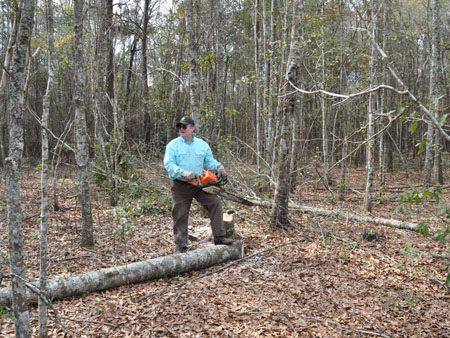 |
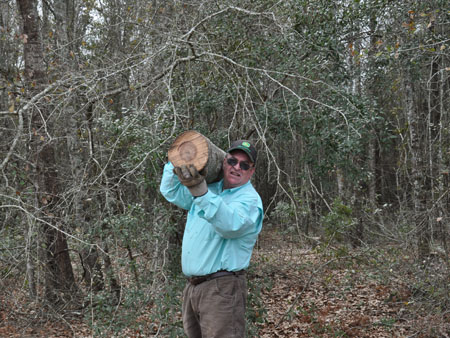 |
Water oaks grow abundantly on the farm, as one notes in the above photo (Jan 30, 2011), which was taken on the northern rim of the bay that lies northwest of the settlement. Except in the wettest weather, this bay is dry now, but was a nice duckpond (nearly waist-deep in someplaces) when I was a teen. Back then, it provided great excitement for a few minutes, about 5:50 pm, the appointed time for the wood ducks to come in for the night. Perhaps it needs to burn again, as it did in my mother's youth, ~ 90 years ago. As a landscape plant, water oaks are not my favorite--they are weedy, short-lived, and prone to drop branches and rot out. Fortunately, though, they are better in my experience than a favorite oak, live oak, for shiitake production (live-oak logs are colonized more slowly, but produce over a longer period than water oaks in my experience). Live oaks also get high marks for mast production. One might say that cutting down water oaks improves the woodlot and that the logs for shiitake production are a byproduct of this stewardship. |
The recommended length for shiitake logs is 40" and I eyeball to about that length. The recommended diameter is 4-8". I like the larger-diameter logs because they dry out less readily. The drawback, illustrated above, is that larger logs have heart wood, which is not invaded easily by shiitake and the mycelium does not grow laterally with ease. For reasons that are hidden too deeply in my mind, I like hard work and walk the logs out (above, instead of loading them in the woodlot or snaking the uncut logs out). In my seventh decade, I've become aware of another disadvantage of larger logs (logs this year ranged from 39 to 96 pounds, numbers I will store away for possible use in calculating hydration levels of the logs during laying). |
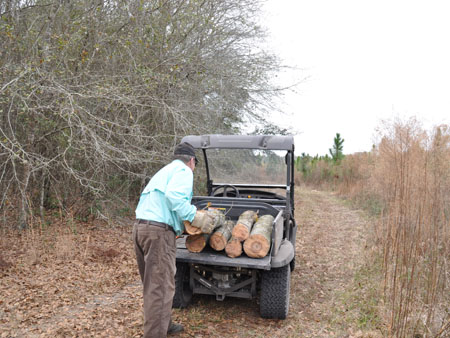 |
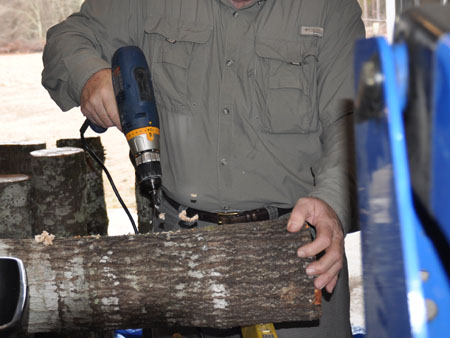 |
I am a glutton for punishment, but I have limits and conveyed the logs to the Drill House in a little utility vehicle. (The Drill House goes by different names; most of the time, I affectionately call it the Tin Shed.) I innoculated the logs the following day. |
I use the simplest equipment, a utility drill with a nominal 7/16" bit with a stop-collar 1" up on the bit. A step up from this is a side-angle grinder with a bit adaptor, which speeds drilling, and beyond that, it gets too fancy to mention here. |
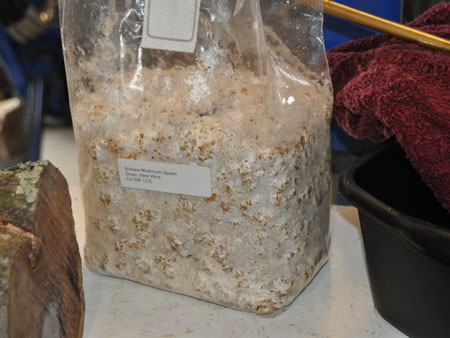 |
|
The goal is to make offset rows of holes spaced 6-8" inches apart, with the row spacing at about 2 ". I try to follow the principle that the mycelium spreads vertically with relative ease (through the lumina of tracheary elements?) and less readily radially, but figure that the main thing is to make a lot of holes in a short period of time . . . . |
Innoculation was with sawdust spawn of 'West Wind,' an undemanding wide-range cultivar suitable for logs. The spawn was purchased from Forest and Field Products, whom I unconditionally recommend. A real person, usually Joe or Mary Ellen, answers the phone; orders are shipped quickly with a follow-up email. Their service, knowledge, and products are excellent (not, of course, to the exclusion of others). |
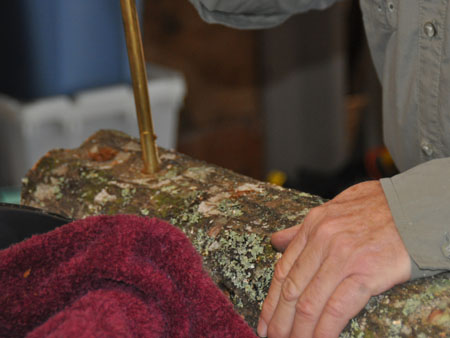 |
|
| Call it a tool and I want it. Regardless, some tools are simply required. The innoculation tool (a gift from my daughter Elizabeth and her husband, John) is hollow and can be stuffed by jabbing it into the spawn, which I keep in in a plastic tub (left). | This closer view shows more of the tub and, importantly, the damp cloth that covers it, thus preventing the spawn from drying out. A plunger (upper left) drives the spawn from the innoculation tool, packing it into the drilled holes. |
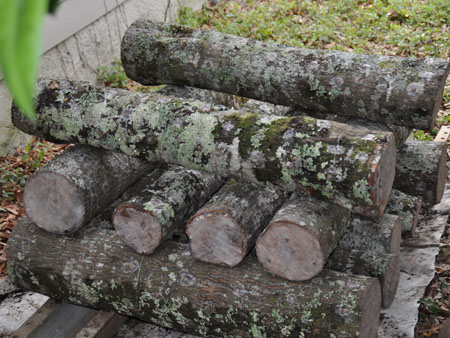 |
|
| I usually stuff about three rows of holes at a go and then daub food-grade cheese wax on the holes to prevent moisture loss. A 1.5-quart crock pot (a gift from the Will Outlaw family) is a handy means of keeping the wax molten. | This time, the laying yard is a shady--very shady--spot between my workshop and satsuma structure. The ground is covered by a piece of above-ground pool liner and the logs are stacked (maybe too closely) on a pair of aluminum runners. (The liner and runners were "gifts" and have been repurposed several times.) In the past, I've covered logs with shade cloth and may do it again. Toward the end of the summer, the logs will be repositioned for a three-year production cycle. |
OK, this is cheating: the log to the left was from a different innoculation, specifically CS 24 ("CS" simply means Cultivated Strain) obtained from Northwest Mycological Consultants. That batch was innoculated on Jan 21, 2007, and the photograph was taken Sep 4, 2008. The most of Tropical Storm Fay came through Tallahassee on Aug 24, 2008, dumping overall about 20" of rain, which provided the fruiting stimulus. Although cheating, it seems better to mix photographs in order to bring the page to its logical end. Postscript. The logs innoculated in this narrative first fruited in early September, 2011 (i.e., a fast spawn run as expected). |
|
| Another postscript (2018). Keeping up the mushrooming! Again, 'West Wind,' with which we've had success, purchased from Forest and Field Products. The logs were cut in the rain (left, below) at the W.H. Outlaw Farm on Jan 28, 2018, and were allowed to rest in our ag building at the farm until innoculation, Feb 5, 2018. In the past, we had always innoculated within a day of harvesting, but this year we went with the updated recommendations (only because of our time constraints). A mixture of large and small water oak (overall, the best performing species of the few we've tried) and one live oak (slower spawn run but longer productivity). On Feb 6, 2018, we brought the logs to the Outlaw Homestead, and put them down for spawn run (right, below). | |
.jpg) |
.jpg) |
Return to Documentation for this page. |
|